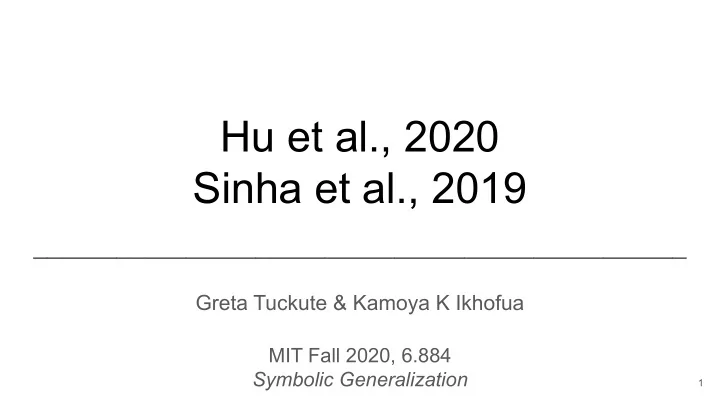

Hu et al., 2020 Sinha et al., 2019 _______________________________________________ Greta Tuckute & Kamoya K Ikhofua MIT Fall 2020, 6.884 Symbolic Generalization 1
Motivation Natural language understanding systems to generalize in a systematic and robust way ● Diagnostic tests - how can we probe these generalization abilities? ○ Syntactic generalization (Hu et al., 2020, “SG”) and logical reasoning (Sinha et al., 2019, “CLUTRR”) ● Evaluation metrics for language models? 2
SG: Man shall not live by perplexity alone Perplexity is not sufficient to check for human-like syntactic knowledge: ● It basically measures the probability of seeing some collection of words together ● However some words which are rarely seen together are grammatically correct ● Colorless green ideas sleep furiously (Chomsky, 1957) ● Need a more fine-grained way to assess learning outcomes of neural language models 3
SG: Paradigm Assess NL models on custom sentences designed using psycholinguistic and syntax literature/methodology ● Compare critical sentence regions NOT full-sentence probabilities. ● Factor out confounds (e.g token lexical frequency, n-gram statistics) 4
SG: Paradigm ● Cover the scope of syntax phenomena: 16/47 (Carnie et al., 2012) ● Group syntax phenomena into 6 circuits based on processing algorithm 5
SG: Circuits 1. Agreement 2. Licensing 3. Garden-Path Effects 4. Gross Syntactic Expectation 5. Center Embedding 6. Long-Distance Dependencies 6
SG: Agreement Chance is 25% (or up to 50%) 7
SG: NPI Licensing ● The word “any” is a negative polarity item (NPI) ● The word “no” can license an NPI when it structurally commands it, such as in A A) No managers that respected the guard have had any luck > B) *The managers {that respected no guard} have had any luck (Reflexive Pronoun Licensing was also included in sub-class suites) 8
SG: NPI Licensing Acceptable orderings: ADBC ADCB DABC DACB ACDB (?) Chance: 5/24 9
SG: Reflexive Pronoun Licensing Chance: 25% 10
SG: NP/Z Garden-Paths 11
SG: Main-Verb Reduced Relative Garden-Paths Chance is 25% 12
SG: Gross Syntactic Expectation (Subordination) 13
SG: Center Embedding 14
SG: Long Distance Dependencies 15
SG: Pseudo-Clefting 16
SG: Assessment accuracy_per_test_suite = correct predictions / total items ● Test for stability by including syntactically irrelevant but semantically plausible syntactic content before the critical region ○ E.g: ○ The keys to the cabinet on the left are on the table ○ *The keys to the cabinet on the left is on the table ● Compare model class to dataset size 17
SG: Score by Model Class 18
SG: Perplexity and SG Score BLLIP-XS: 1M tokens BLLIP-S: 5M tokens BLLIP-M: 14M tokens BLLIP-LG: 42M tokens 19
SG: Perplexity and SG Score 20
SG: Perplexity and Brain-Score 21 Schrimpf et al., 2020
SG: The Influence of Model Architecture 22
SG: The Influence of Model Architecture ● Architectures as priors to the linguistic representation that can be developed ● Robustness depends on model architecture 23
SG: The Influence of Dataset Size 24
SG: The Influence of Dataset Size 25
SG: The Influence of Dataset Size ● Increasing amount of training data yields diminishing returns: ○ “(...) require over 10 billion tokens to achieve human-like performance, and most would require trillions of tokens to achieve perfect accuracy – an impractically large amount of training data, especially for these relatively simple syntactic phenomena.” (van Schijndel et al., 2019) ● Limited data efficiency ● Structured architectures or explicit syntactic supervision ● Humans? 11-27 million total words of input per year? (Hart & Risley, 1995; Brysbaert et al., 2016) 26
SG: The Influence of Dataset Size 27
CLUTRR: Motivation and Paradigm ● C ompositional L anguage U nderstanding and T ext-based R elational R easoning ● Kinship inductive reasoning ● Unseen combinations of logical rules ● Model robustness 28
CLUTRR: Motivation and Paradigm ● Productivity ○ mother(mother(mother(Justin))) ~ great grandmother of Justin ● Systematicity ○ Only certain sets allowed with symmetries: son(Justin, Kristin) ~ mother(Kristin, Justin) ● Compositionality ○ son(Justin, Kristin) consists of components ● Memory (compression) ● Children are not exposed to systematic dataset 29
CLUTRR: Dataset Generation & Paradigm 30
CLUTRR: Model Robustness 31
CLUTRR: Systematic Generalization 32
CLUTRR: Model Robustness 33
CLUTRR: Model Robustness (noisy training) 34
Future work & Perspectives ● Sub-word tokenization ● Active attention and reasoning ● Generalization across tasks ● Abstractions as probabilistic ● Architecture and dimensionality reduction 35
References Brysbaert, M., Stevens, M., Mandera, P., & Keuleers, E. (2016). How Many Words Do We Know? Practical Estimates of Vocabulary Size Dependent on Word Definition, the Degree of Language Input and the Participant's Age. Frontiers in psychology , 7 , 1116. https://doi.org/10.3389/fpsyg.2016.01116 Hart, B., & Risley, T. R. (1995). Meaningful differences in the everyday experience of young American children . Baltimore, MD: Paul H. Brookes Publishing Company. Schrimpf, M., Blank, I., Tuckute, G., Kauf, C., Hosseini, E. A., Kanwisher, N., Tenenbaum, J., Fedorenko, E (2020): Artificial Neural Networks Accurately Predict Language Processing in the Brain, bioRxiv 2020.06.26.174482; doi: https://doi.org/10.1101/2020.06.26.174482. Van Schijndel, M., Mueller, A., & Linzen, T. (2019). Quantity doesn't buy quality syntax with neural language models. arXiv preprint arXiv:1909.00111 . 36
Supplementary 37
CLUTTR, Fig. 6 38
CLUTTR, Table 5 39
CLUTTR, Table 4 40
CLUTTR, Fig. 7 41
Van Schijndel et al., 2019 42
Recommend
More recommend